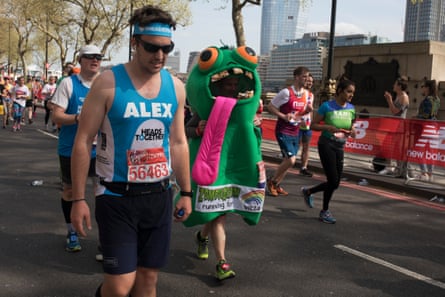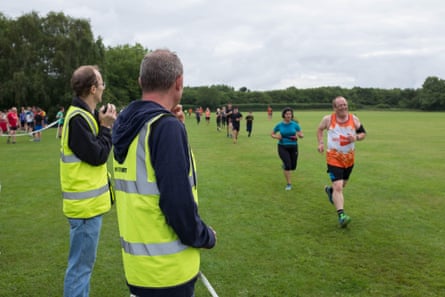
Running is a sport governed by the clock. The four-minute mile. The two-hour marathon. The 10-second 100m. Recreational runners – a country mile away from breaking these barriers – still chase times, pore over “splits” (minutes a mile or kilometre) and obsess over shaving minutes, or seconds, from their personal bests.
But change is afoot. Away from the business end of the sport, where records continue to tumble, running’s vital statistics are getting slower. Between 1986 and 2018, the average finish time for a 10km race slipped by about 12 minutes and for a marathon, by 39 minutes.
The biggest factor in the slowdown is that running has become a broader church. A glance at any start line confirms that there are runners of all ages, abilities, shapes and sizes, a far cry from when I started out, more than 30 years ago, when race participants were uniformly skinny, swift, club-vested – and mostly male.
Martinus Evans, 36, is the proud owner of eight marathon medals. His running journey began 11 years ago, when his doctor told him: “Mr Evans, you’re fat. You have two options: lose weight or die.” At the time he weighed 21st 7lb (136kg). Evans announced he would run a marathon, much to the doctor’s derision. But he went on to do exactly that and has since completed more than 100 other races. “Running has nothing to do with a number on a scale or a time on a stopwatch,” he says.
Evans set up, and is now in charge of the Slow AF Run Club, a virtual club with more than 10,000 members, and his book of the same name came out last month. “My message is that running is for anyone and that you can do it in the body you have right now,” he says.
Evans’s experiences in past events – being called “fat and slow” by the driver of the “sweeper vehicle” that brings up the rear, getting lost because route signage had been taken down and crossing finish lines to find no medals or water left – might suggest that not everyone agrees. However, he believes the outlook for non-traditional runners is improving. “One race director said that after he read my story, he started to offer finisher T-shirts up to size 3XL,” he says.
In 2020, after consultation with slower runners who had reported negative experiences at the previous year’s event, the London Marathon launched its “back-of-the-pack” initiative. The finish line on the Mall now remains open until 7.30pm, with 50 “tailwalkers” starting at the back of the final wave on all three starts and moving at eight-hour marathon pace (18 minutes and 18 seconds a mile). A tailwalker will drop back to support any runner struggling to maintain that pace, moving on to the pavement with them and accompanying them to the finish line. “Drinks stations and timing mats remain in place until all tailwalkers have passed,” says Lianne Hogan, the event’s communications manager.
Even after the official finish line closes, an alternative one in St James’s Park is open for those coming in later than 7.30pm. “All participants who finish on marathon day and have not left the course at any point will get a medal,” says Hogan.
Lisa Jackson, a member of the 100 Marathon Club and author of Your Pace or Mine? welcomes the move. “I think races should extend their cutoffs if they can. Why exclude anyone?”
Jackson describes herself as “born genetically slow”, and has finished last in 20 of her 110 marathons. “My attitude to racing is that it is about the time you have, not the time you do,” she says. “I’m a driven person, but not time-focused at all. I don’t want to be looking at my watch all the time. What’s important to me is the connections I make with others. I love talking to people, and the people at the back of the pack talk more.”
Jackson’s disregard for speed is music to the ears of Bethan Taylor-Swaine, who is researching problems around inclusivity in running for her PhD. “We need to move away from pace as the sole marker of success and find other ways of interpreting or rating running experiences,” she says. “I’ve no problem with people chasing times, but let’s also talk about what else we value about running.”

Parkrun, the global series of free weekly 5km timed events, has played an instrumental role in filling the pews of running’s broader church, if not prising the doors open in the first place. Parkrun is not a race but a run (although you will still see fingers poised over watches at the start line) and has no time limit for its 5km distance. As each event has a volunteer tailwalker bringing up the rear, it is impossible to come last. “We’re changing the traditional narrative around what running should be, making it more spacious and inclusive,” says Chrissie Wellington, a four-time Ironman world champion and Parkrun’s head of health and wellbeing.
The average finish time in 2005 was 22 minutes 17 seconds whereas in 2023, it is 32 minutes 34 seconds. “We’re proud that our finish times are getting longer,” says Wellington. “We’re getting better at giving more people the opportunity and space to walk or run at whatever pace they feel comfortable. Ultimately, it’s about movement. There are incredible health benefits from running at any pace, and from walking.”
Wellington makes an important point when I use the term “slow running”. “There are many reasons why people might choose, or need, to run slowly,” she says. “Speed is relative. One person’s leisurely pace is another’s maximum effort. Finish time can be just as important to a slower runner as to a fast one.”
Taylor-Swaine no longer tells people her race finish times, as part of her attempt to broaden the conversation about running. “It really gets some people’s backs up,” she says. “I’ve been accused of not being a ‘real’ runner.” Instead, her suggested questions to ask runners at the finish line include: “How did you feel?”, “What was your highlight?” and “How will you celebrate?”
I admit that I have always kept a close eye on my time. When my performances started to decline with age, I found my enjoyment of racing following suit.
That has not been the case for former British elite marathoner Tina Muir (personal best 2hr 36min), who retired from professional running in 2017, aged 28. I am intrigued to know how she continues to derive satisfaction from crossing a finish line, despite her best times being behind her. “It took a while not to care what the result next to my name said and what people would think,” she says. “My first race as a non-professional athlete was miserable as I hadn’t let go of the habit of pushing myself to the brink. But gradually I realised I really enjoyed running when I wasn’t obsessing over the result. I just ran a 10km in 1hr 4min – my slowest ever by far – and it was so much fun!”
I have found a different way to recalibrate my relationship with running as I have got slower. I have stopped racing entirely, swapping performance targets for goals such as stress reduction, time in nature, mental and physical health. I am not alone. Sarah Kern, a runner for 25 years, also gave up racing six years ago. “Running can be so comparative,” she says. “It’s all about performance goals. Every time I signed up for a race, I’d either lose all motivation to train or get injured. Now I run because I want to be out there. I love the headspace, being in nature. It’s quite liberating not to care any more about my pace. I’ll run a bit, walk a bit, stop and take pictures of the bunnies.”
We slow runners even have a new vocabulary that is far more positive than words such as “plod” and “shuffle”: “Jeffing”, which describes a walk-run combo (named after Jeff Galloway, the US Olympian who was a fan of it as a coaching technique); “picnic pace” (used by ultrarunners) and my favourite, Martinus Evans’s “sexy pace”.
I suspect there will be naysayers reading this who will grumble that 18, 16 or even 12 minutes a mile isn’t “proper running”. Perhaps they will suggest that people should train more or lose weight before they toe a start line. But as the slow running movement gathers pace, they will be the ones left behind.


